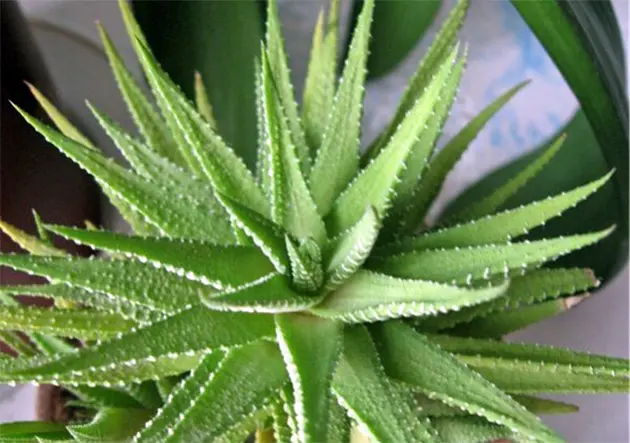The healing properties of aloe, or sabur, have been known since the time of the Egyptian pharaohs. The leaves of this plant were used for severe burns, long-healing ulcers, and wounds. We shouldn’t forget the wisdom of our ancestors: if you get burned, immediately mix aloe juice with an equal amount of honey and apply it to the affected area as often as possible. The burn will heal quickly. If you prick your finger and develop an abscess, you can treat it this way: take a washed leaf, cut it open, and apply it to the wound, covering it with compress paper and then bandaging it. After a few hours, the abscess will burst, but keep the bandage on for about 12-14 hours to ensure complete drainage and quick healing.
For poor digestion and to regulate the menstrual cycle, take 8-10 drops of aloe juice twice a day.
Here’s a recipe used for chronic colitis and constipation: take 150 grams of aloe leaves, chop them up, and pour 300 grams of hot, but not boiling, honey over them. Let it steep for a day. After straining, warm it up and drink 5-10 grams an hour before breakfast. However, it’s important to remember that consuming aloe juice internally is contraindicated during pregnancy, with liver and gallbladder diseases, hemorrhoids, cystitis, and uterine bleeding. The aloe emulsion sold in pharmacies is used to prevent and treat skin lesions caused by radiation sickness.
The American agave looks similar to aloe. There’s a belief that they share similar healing properties. However, caution is advised when consuming agave internally, as its chemical composition is not yet fully understood. Agave juice acts faster and more effectively than aloe, but it can cause mild inflammation in people with sensitive skin. When using agave, always select leaves from plants that are at least three years old. Of the two types of agave—one with dark green leaves and the other with light green leaves edged in white—the latter is more suitable for treatment. For sciatica, cut the agave leaves and apply them to the affected area for 2-3 hours before bedtime.
To remove warts, you can use the wonderful euphorbia. Cut it and apply the juice to the warts, then wash it off after 20-30 minutes. This procedure should be repeated two to three times a day. However, be cautious: wash your hands thoroughly after the procedure, as the sap of euphorbia is highly toxic.
Many home cooks love climbing plants, with ivy being the most common. Its leaves are used externally for calluses, warts, purulent wounds, and burns. According to Bulgarian researchers, for gout and rheumatism, a cold infusion of ivy leaves should be taken internally. To make this, steep half a teaspoon of chopped leaves in a cup of cold water for 8 hours, strain, and drink a tablespoon four to five times a day for a week.
Tradescantia brightens up rooms with its lush, drooping stems and sharp leaves. If it doesn’t get enough water, some stems will dry out. By caring for our plants, we learn more and shouldn’t discard them. The stems can be chopped (5 grams is enough), poured over with a cup of boiling water, steeped for 30 minutes, and consumed in three doses throughout the day. Swedish doctors have observed that this infusion contains many biostimulants. It improves the functioning of the liver, spleen, and bone marrow.
Crimson geranium blooms beautifully on the windowsill. One of its varieties is the blood-red geranium. Its rhizome is used to treat bronchitis, pulmonary tuberculosis, diarrhea, and dysentery. For this, two teaspoons of chopped rhizomes are steeped in two cups of cold water for 8 hours, strained, and consumed throughout the day. For nosebleeds, tampons soaked in this infusion can be inserted. For eczema, dermatoses, and burns, compresses made from the geranium rhizome infusion are applied. For joint inflammation, compresses are also used. A runny nose, just starting, can be treated with juice from a geranium leaf (1-3 drops in each nostril 3-5 times a day).
And what a unique plant the physalis is! Its stem, abundantly covered with leaves, is adorned with fiery orange lanterns that resemble slightly elongated balloons. Inside each lantern is a fiery red berry. These fruits are recommended as a diuretic for kidney stones, bladder issues, as well as for inflammation of the urinary organs, dropsy, gout, and joint rheumatism. The fruits can be used to make a decoction: boil 15-20 dried berries in 0.5 liters of water for 5-7 minutes. This decoction should be sipped in small gulps over two days. Alternatively, you can simply eat 10-15 fruits. However, the lantern itself is toxic.
Our windowsill garden is quite diverse, so in conclusion, here’s a tip: use your windowsills and room space wisely. When selecting green companions, start with the first-aid plants—aloe, agave, cyclamen—before adding others.

